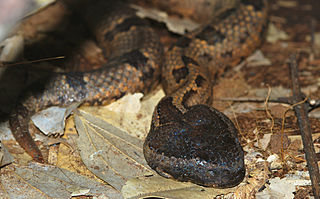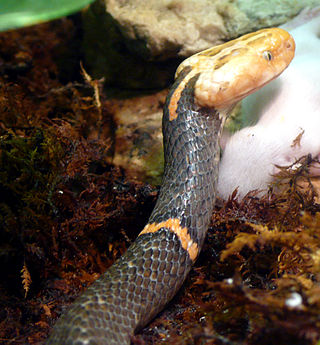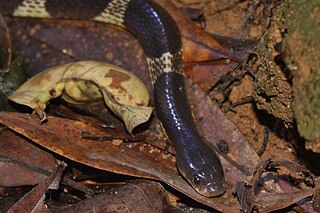The Uropeltidae, also commonly known as shield tail snakes, shield-tailed snakes or earth snakes, are a family of primitive, nonvenomous, burrowing snakes native to Peninsular India and Sri Lanka. The name is derived from the Greek words ura ('tail') and pelte ('shield'), indicating the presence of the large keratinous shield at the tip of the tail. Seven or eight genera are recognized, depending on whether Teretrurus rhodogaster is treated in its own genus or as part of Brachyophidium. The family comprises over 50 species. These snakes are not well known in terms of their diversity, biology, and natural history.

Xenopeltis, the sunbeam snakes, are the sole genus of the monotypic family Xenopeltidae, the species of which are found in Southeast Asia. Sunbeam snakes are known for their highly iridescent scales. Three species are recognized, each one with no subspecies. Studies of DNA suggest that the xenopeltids are most closely related to the Mexican burrowing python and to the true pythons (Pythonidae).

Tiger snakes are a large and highly venomous snake of southern Australia, including its coastal islands and Tasmania. These snakes are often observed and locally well known by their banding, black and yellow like a tiger, although the species can be highly variable in coloration and patterning. All populations are classified within the genus Notechis (Elapidae). Their diverse characteristics have been classified either as distinct species or by subspecies and regional variation.

The banded krait is a species of elapid snake found on the Indian Subcontinent, in Southeast Asia, and in southern China. It is the largest species of krait, with a maximum length up to 2.7 m.

Xenopeltis unicolor is a non-venomous sunbeam snake species found in Southeast Asia and some regions of Indonesia. This is a primitive snake known for both its highly iridescent scales and its ability to reproduce quickly, as it is oviparous and as such can lay up to 10 eggs at a time. No subspecies are currently recognized.

Ovophis monticola, commonly known as the Chinese mountain pit viper, is a venomous pitviper species found in Asia. Currently, two subspecies are recognized, including the nominate subspecies described here. Recent taxonomic work suggests that most of these should be considered as separate species. IUCN has already evaluated O. m. makazayazaya as Ovophis makazayazaya.

Trimeresurus medoensis, commonly named the Motuo bamboo pitviper, is a venomous pitviper species endemic to India, Burma, and Tibet. No subspecies are currently recognized.

Trimeresursus stejnegeri is a species of venomous pit viper endemic to Asia. Two subspecies are currently recognized, including the nominate subspecies described here.

Ahaetulla prasina is a species of snake in the family Colubridae to southern Asia. Its common names include Asian vine snake, Boie's whip snake, Gunther's whip snake, Oriental whip snake, Judgmental Shoelace.

Chrysopelea ornata is a colubrid snake found in both South and Southeast Asia. It is, along with the other species in its genus Chrysopelea, very unusual in that it is capable of a type of gliding flight. It is also rear-fanged. Currently, three subspecies are recognized. The snake's striking looks and capability of gliding make it a popular choice for captivity.

Oligodon cinereus, the ashy kukri snake, ashy kukri snake, black cross-barred kukri snake, golden kukri snake, or Günther's kukri snake, is a species of snake in the family Colubridae.

The checkered keelback, also known commonly as the Asiatic water snake, is a common species in the subfamily Natricinae of the family Colubridae. The species is endemic to Asia. It is non-venomous.

Azemiopinae is a monogeneric subfamily created for the genus Azemiops that contains the viper species A. feae and A. kharini. They are commonly known as Fea's vipers. No subspecies are recognized. The first specimen was collected by Italian explorer Leonardo Fea, and was described as a new genus and new species by Boulenger in 1888. Formerly considered to be one of the most primitive vipers, molecular studies have shown that it is the sister taxon to the pit vipers, Crotalinae. It is found in the mountains of Southeast Asia, in China, southeastern Tibet, and Vietnam. Like all other vipers, they are venomous.

The Chinese cobra, also called the Taiwan cobra, is a species of cobra in the family Elapidae, found mostly in southern China and a couple of neighboring nations and islands. It is one of the most prevalent venomous snakes in China and Taiwan, which has caused many snakebite incidents to humans.

The many-banded krait, also known as the Taiwanese krait or the Chinese krait, is a venomous species of elapid snake found in much of central and southern China and Southeast Asia. The species was first described by the scientist Edward Blyth in 1861. Averaging 1 to 1.5 m in length, it is a black or bluish-black snake with many white bands across its body. The many-banded krait mostly inhabits marshy areas throughout its geographical distribution, though it does occur in other habitat types.
Trimeresurus stejnegeri chenbihuii, commonly known as the Chen's bamboo pitviper, is a subspecies of venomous pitviper in the family Viperidae. The subspecies is endemic to Hainan Island in China.

Atractaspis duerdeni, commonly known as the beaked burrowing asp, Duerden's burrowing asp, and Duerden's stiletto snake, is a species of venomous snake in the family Atractaspididae. The species is native to southern Africa.

The prong-snouted blind snake is a species of non-venomous worm-like burrowing snakes belonging to the Typhlopidae family. It is endemic to central southern, continental Australia.

Achalinus formosanus, common name Formosan odd-scaled snake or Taiwan burrowing snake, is a non-venomous snake in family Xenodermidae that is found in Taiwan and in the southern Ryukyu Islands (Japan).
Xenopeltis intermedius is a non-venomous sunbeam snake species found in Vietnam.

















